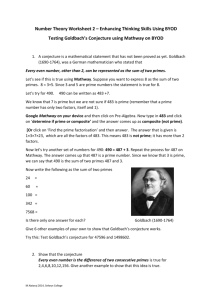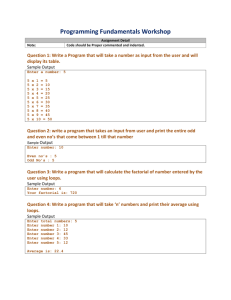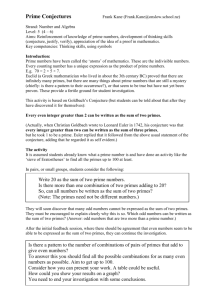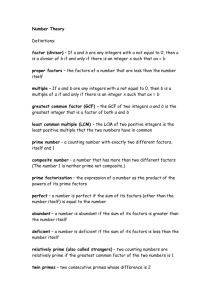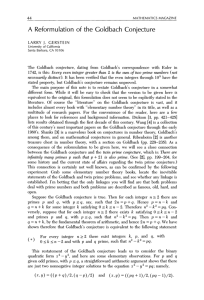NUMBER THEORETIC PROGRAMS FOR THE TI-89
advertisement
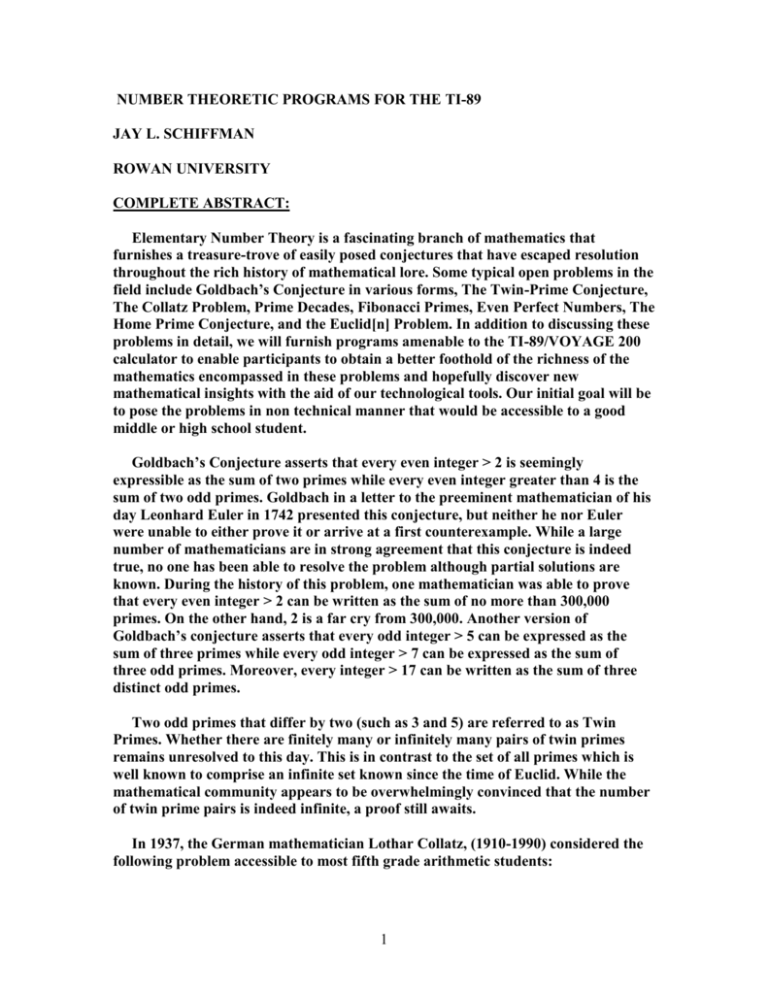
NUMBER THEORETIC PROGRAMS FOR THE TI-89 JAY L. SCHIFFMAN ROWAN UNIVERSITY COMPLETE ABSTRACT: Elementary Number Theory is a fascinating branch of mathematics that furnishes a treasure-trove of easily posed conjectures that have escaped resolution throughout the rich history of mathematical lore. Some typical open problems in the field include Goldbach’s Conjecture in various forms, The Twin-Prime Conjecture, The Collatz Problem, Prime Decades, Fibonacci Primes, Even Perfect Numbers, The Home Prime Conjecture, and the Euclid[n] Problem. In addition to discussing these problems in detail, we will furnish programs amenable to the TI-89/VOYAGE 200 calculator to enable participants to obtain a better foothold of the richness of the mathematics encompassed in these problems and hopefully discover new mathematical insights with the aid of our technological tools. Our initial goal will be to pose the problems in non technical manner that would be accessible to a good middle or high school student. Goldbach’s Conjecture asserts that every even integer > 2 is seemingly expressible as the sum of two primes while every even integer greater than 4 is the sum of two odd primes. Goldbach in a letter to the preeminent mathematician of his day Leonhard Euler in 1742 presented this conjecture, but neither he nor Euler were unable to either prove it or arrive at a first counterexample. While a large number of mathematicians are in strong agreement that this conjecture is indeed true, no one has been able to resolve the problem although partial solutions are known. During the history of this problem, one mathematician was able to prove that every even integer > 2 can be written as the sum of no more than 300,000 primes. On the other hand, 2 is a far cry from 300,000. Another version of Goldbach’s conjecture asserts that every odd integer > 5 can be expressed as the sum of three primes while every odd integer > 7 can be expressed as the sum of three odd primes. Moreover, every integer > 17 can be written as the sum of three distinct odd primes. Two odd primes that differ by two (such as 3 and 5) are referred to as Twin Primes. Whether there are finitely many or infinitely many pairs of twin primes remains unresolved to this day. This is in contrast to the set of all primes which is well known to comprise an infinite set known since the time of Euclid. While the mathematical community appears to be overwhelmingly convinced that the number of twin prime pairs is indeed infinite, a proof still awaits. In 1937, the German mathematician Lothar Collatz, (1910-1990) considered the following problem accessible to most fifth grade arithmetic students: 1 Consider any positive integer. If it is even, divide by two. If it is odd, triple and add one. Repeat the above process on each new number obtained. Eventually after finitely many steps, this iterative sequence will converge to one. While this problem has been successfully tested on all integers below 10^23, it has not been proven in general. A variation on this conjecture generally requiring fewer iterations is to take any odd integer, triple its value, add one and divide the resulting sum by two. The problem takes on various names including Ulam’s Conjecture and The Syracuse Problem as indicators of the people and places that have studied the problem in depth. A prime decade is a set of ten integers from n0 to n9 (where n is a positive integer of any length) such that n1, n3, n7, and n9 are all primes. (Of course all primes with the exception of 2 and 5 terminate in one of the digits 1, 3, 7, and 9). Thus in the sequence of ten integers one has a pair of twin primes twice. For example, 11, 13, 17, and 19 constitutes a prime decade while the next one is 101, 103, 107, and 109. The question that remains unresolved is whether there are infinitely many prime decades. The set of prime Fibonacci numbers includes 2, 3, 5, 13, 89, and 233. The question as to whether there are infinitely many prime Fibonacci numbers is unknown. Some partial results are known. For example, with the exception of 3 (the fourth member of the sequence), any Fibonacci prime must be an element that is a prime number as far as positioning in the sequence. For example, the twentieth Fibonnaci number is not prime since 20 is not a prime. The converse is not true, however. Even perfect numbers such as 6, 28, and 496 in which the sum of all the proper divisors of the number coincided with the number were known since the time of Euclid. Whether there are infinitely many such numbers is unknown. The Home Prime Conjecture introduced to me by Dr. Neil A.J. Sloane at an MAA lecture in 2002 refers to the concatenation of composite integers. Take a composite integer, factor it and concatenate the factors into a new integer. Repeat the process. Eventually you should obtain a prime, called the Home Prime of the original integer. This conjecture is stalled after 100 steps for the integer 49. It is unknown whether every integer has a Home Prime. Euclid [n] refers to the product of the first n primes plus one and is featured in the classical proof on the infinitude of primes by Euclid. The question of whether there are infinitely many prime outputs in this sequence remains open. With the inclusion of simple programs designed for the calculator and MATHEMATICA as well as referencing the World Wide Web to sites such as MathWorld – A Wolfram Resource, we will enable the participants to obtain a deeper understanding of these problems that have fascinated mathematicians throughout the ages which might lead to some new results. 2

